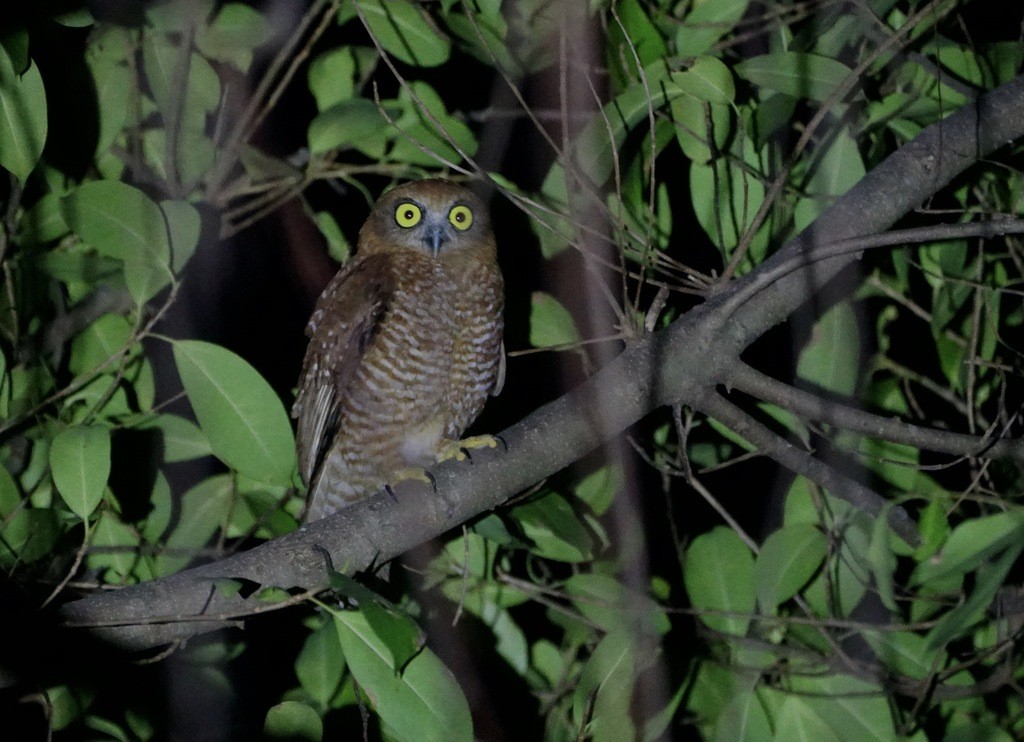Christmas Island Hawk-owl
A species of Asian and Australasian Hawk-owls and Boobooks, Also known as Christmas Boobook Scientific name : Ninox natalis Genus : Asian and Australasian Hawk-owls and Boobooks
Christmas Island Hawk-owl, A species of Asian and Australasian Hawk-owls and Boobooks
Also known as:
Christmas Boobook
Botanical name: Ninox natalis
Genus: Asian and Australasian Hawk-owls and Boobooks
Content
Description General Info
 Photo By catalinatong , used under CC-BY-NC-4.0 /Cropped and compressed from original
Photo By catalinatong , used under CC-BY-NC-4.0 /Cropped and compressed from original Description
The Christmas Island hawk-owl is a small, rufous-brown hawk-owl with a barred breast, dark chestnut facial mask, whitish brow, lores and throat, yellow eyes, legs and feet. It is approximately 26–29 cm in length and 130-190 grams in weight with the female slightly larger than the male. Its double-noted hoot, boo-book, has a clucking quality with the second note usually lower in pitch. The begging call of juveniles is a high-pitched trill. Vocalisations are similar to those described for the Australian boobook (Ninox boobook) and include individual variation in advertisement calls. This may be useful in estimating owl densities as radio-tracking can be impractical in some terrains. 
Size
29 cm
Nest Placement
Tree
Feeding Habits
Christmas Island Hawk-owl consumes a diet mainly of medium to large insects, notably beetles and moths, alongside vertebrates like geckos and black rats. It hunts these prey using specialized foraging techniques specific to its habitat.
Habitat
The christmas Island Hawk-owl inhabits subtropical or tropical moist lowland forests and shrublands with a dense canopy and significant tree diversity. Preferring deep cover and sheltered roosts in the lower canopy, particularly in tree hollows of specific species, christmas Island Hawk-owl tends to avoid areas with sparse understory. Their presence is more prevalent in primary forests than in secondary or regrowth areas.
Dite type
Carnivorous
General Info
Feeding Habits
Bird food type
Distribution Area
N. natalis is endemic to Christmas Island, a small Australian territory of about 135 square km situated in the Indian Ocean approximately 360 km south of Java. The flora and fauna of the island face on-going threats from both human activity and introduced species of plants and animals. In addition to these threats, N. natalis is restricted to a small range on this small island and is consequently listed as vulnerable by the IUCN Phosphate mining has continued for over a century and more recently Australian Immigration Detention Facilities have been established increasing the impact from human habitation. However, the Australian National Parks and Wildlife Service manage 64% of the island as a national park. 
Species Status
Man-made habitat destruction together with the introduction of species such as the yellow crazy ant (Anoplolepis gracillipes), cats (Felis catus) and black rats are among the major threats to both the habitat and native wildlife, including the Christmas Island hawk-owl. The yellow crazy ant Anoplolepis gracilipes, an invasive introduction, disrupts the habitat in a number of ways, but most notably through their elimination of populations of the island's keystone species the red crab (Gecarcoidea natalis) resulting in significant changes to forest composition. In addition, the ants mutually-beneficial relationship with scale insects has contributed to degradation of the canopy. It is thought that yellow crazy ants may also prey on nestlings. While mining has largely ended, various programmes to monitor and control introduced species are on-going. 